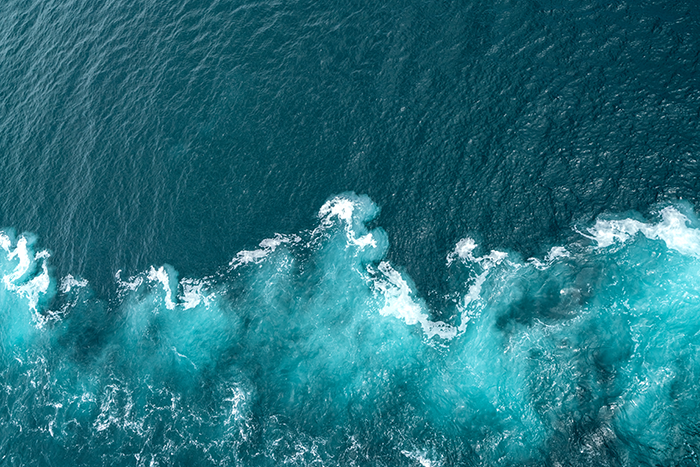Analyses / Ocean
1 October 2025
Summer 2025: international ocean governance takes a step forward, but fault lines remain

Summer 2025 will stand out as a pivotal moment in the architecture of international ocean governance. The six major issues structuring this summer’s multilateral agenda – the third United Nations Ocean Conference (UNOC3), the ratification of the treaty on biodiversity beyond national jurisdiction (the so-called BBNJ treaty), negotiations at the International Seabed Authority (ISA), the World Trade Organization (WTO) agreement on fisheries subsidies, the future global treaty on plastics, and the decarbonisation of maritime transport at the International Maritime Organization (IMO) – all saw significant developments. While some historic milestones have been achieved, others highlight the extent of resistance and the persistence of power struggles. Taken together, they outline a system of ocean governance that is consolidating yet still traversed by deep political fractures.
UNOC3: political affirmation and convergence of agendas
The third United Nations Ocean Conference, held in Nice in June 2025, saw the adoption by consensus of a political declaration entitled “Our Ocean, Our Future: United for Urgent Action”. This text, also known as the Nice Ocean Action Plan, reaffirms that the ocean is essential to life on Earth and stresses the “global emergency” it faces, particularly due to climate change, biodiversity loss and pollution. Endorsed on 30 June by the UN General Assembly following a vote (162 in favour, 1 against (United States), and no abstentions), it stands as a common roadmap.
UNOC3 also acted as an orchestrator and catalyst, bringing together sectoral negotiations that usually take place in highly compartmentalised arenas. By gathering an unprecedented number of heads of state and government, the Nice conference was a diplomatic success in terms of participation and political visibility, lending greater legitimacy to the debates. By creating this space of convergence, it temporarily provided coherence to a fragmented landscape. Yet this visibility also raises expectations, as states will now have to prove that the political commitments expressed translate into tangible progress within specialised forums.
BBNJ: the culmination of a long diplomatic cycle
Adopted in 2023 after nearly twenty years of negotiations, the treaty on biodiversity beyond national jurisdiction (BBNJ) establishes a legally binding framework for the protection of the high seas, notably by regulating the creation of marine protected areas, the conduct of environmental impact assessments, and the sharing of benefits from marine genetic resources. Reaching the 60 ratifications required for its entry into force was one of UNOC3’s main goals. The diplomatic effort deployed in the preceding months, intensified around the conference, paid off: on 19 September 2025, the sixtieth instrument of ratification was deposited at the United Nations, paving the way for the treaty’s entry into force on 17 January 2026. This milestone illustrates both the scale of diplomatic mobilisation and the political will to give substance to a long-awaited instrument of high seas governance.
Meanwhile, the Preparatory Committee (PrepCom) has already met twice, in April and again in August, to lay the groundwork for the first Conference of the Parties (COP1) scheduled after the treaty’s entry into force. These sessions made progress on the building blocks of the new institutional architecture: drafting rules of procedure, setting up a scientific and technical committee, sketching financial support mechanisms for developing countries, and so on. They also began considering the practical modalities for establishing high seas marine protected areas and for coordinating with existing organisations and institutions such as regional fisheries management organisations (RFMOs).
ISA: between regulatory deadlock and industrial pressure
The summer session of the International Seabed Authority (ISA) Council, held in July 2025, ended without the adoption of exploitation regulations. In the absence of a mining code, no commercial extraction can legally be launched, confirming a de facto freeze of activities. Negotiations continue nonetheless, with the ISA still tasked with elaborating a regulatory framework for potential deep-sea mining activities. The real turning point, however, lies elsewhere: the ISA decided to launch a formal inquiry into the actions of The Metals Company (TMC), which sought to bypass the multilateral framework by seeking deep-sea mining licences under US law. By addressing this case, the Authority is asserting itself not merely as a technical manager, but as an institutional guardian of the law of the sea regime, determined to defend its integrity against industrial pressure.
On the political front, 38 states have now come out in favour of a pause, moratorium or outright ban on deep-sea mining, giving growing visibility to this position. This movement is also supported by major economic players: on 15 July, 40 financial institutions representing over €3.8 trillion in assets called on governments not to authorise exploitation while scientific and regulatory uncertainties remain. To date, 69 companies have signed a joint declaration calling for a moratorium on seabed mining. By combining political backing with financial leverage, this mobilisation places the precautionary principle at the heart of the international debate, making it increasingly difficult to ignore in upcoming negotiations.
WTO: an unprecedented normative step for the environment
Another international agreement now set to enter into force, the WTO agreement on fisheries subsidies crossed the threshold of two-thirds ratifications required on 15 September 2025. This is unprecedented, as for the first time the WTO has adopted a multilateral agreement with explicit environmental scope, aiming to curb the most harmful public subsidies for the sustainability of fishery resources. The text notably prohibits subsidies to illegal, unreported and unregulated (IUU) fishing, to fleets operating on overfished stocks without corrective measures, and to activities in the high seas outside the scope of RFMOs. Beyond its concrete impact on industrial fishing, the agreement represents a normative precedent in demonstrating that the WTO can integrate sustainability objectives, paving the way for a linkage between trade and environmental protection. The outcome will depend on two factors: countries’ ability to comply, and the conclusion of a “Fish2” agreement on overcapacity. If this second component succeeds, it could become one of the most powerful tools against overfishing.
Plastics treaty: a revealing deadlock
The second part of the fifth session of the Intergovernmental Negotiating Committee (INC-5.2), held in Geneva in August 2025, ended without a global agreement on a future treaty to end plastic pollution. Discussions stalled on the most political issue: should the treaty address the entire life cycle of plastics, including upstream production, or focus only on downstream management, through collection, recycling and waste treatment? The High Ambition Coalition, led in particular by the European Union and bringing together over 70 states, including several from Latin America and the Pacific, supports a binding “cradle-to-grave” approach that includes production reduction[1]. Opposing them, major plastic-producing states reject any upstream limits, favouring waste regulation and improved recycling.
This deadlock exposes the structural fractures of global environmental governance: on one side, plastic and hydrocarbon producers; on the other, those bearing the heaviest impacts. Added to this are persistent North–South tensions over differentiated responsibilities, and the decisive influence of industrial interests. The impasse forced negotiators to postpone the adoption of a final text and to consider an additional session in 2026 (INC-6), even though the UN General Assembly had initially set 2024 as the deadline for concluding an agreement.
IMO: climate ambition put to the test
The International Maritime Organization (IMO) now finds itself at a decisive point in its decarbonisation pathway. After adopting in 2023 a revised strategy aiming for carbon neutrality “around 2050”, discussions continued in 2025 on operational measures to implement this goal. Once buoyed by optimism, the negotiations stumbled in spring 2025 over the withdrawal of the United States, which rejected any binding system of taxation or global regulation[2][3]. This stance destabilised the talks and strengthened the hand of reluctant states. The next milestone, set for October 2025, will be crucial: the IMO must decide by a two-thirds majority on the adoption of binding measures. Two scenarios emerge: either the IMO adopts a global framework providing common visibility for the sector, or the failure of negotiations leads to normative fragmentation, with a proliferation of regional initiatives – such as the integration of shipping into the EU Emissions Trading System (ETS) or specific fuel standards. The future of maritime transport regulation will thus depend on the IMO’s ability to reconcile climate ambition with shared norms: without global consensus, the sector risks fragmenting into a patchwork of competing standards.
Conclusion
The year 2025 therefore marks a mixed stage in international ocean governance. On the one hand, legal consolidation is advancing with the forthcoming entry into force of the BBNJ treaty and the WTO agreement on fisheries subsidies. These developments reflect a strengthening and thickening of the law of the sea, enhancing the normative dimension of ocean multilateralism by providing the international community with concrete tools to better regulate the exploitation and protection of marine resources. On the other hand, political polarisation is deepening, exposing systemic fragilities. Negotiations on shipping decarbonisation at the IMO and on the future plastics treaty are stalling on major blockages, aggravated by the United States’ deliberate obstructionist posture. They highlight the persistence of a structural divide in international maritime governance: between the need for stronger environmental ambitions and the weight of dominant economic interests.
Whether upcoming deadlines will steer these tensions towards a consolidation of the global framework or extend a dynamic of fragmentation – with each forum reflecting its own power struggles – remains to be seen.
[1] Charles Pekow, “As plastics treaty talks break down, are there paths to a breakthrough?”, Mongabay, 29 August 2025. See also: European Commission, “EU Seeks Ambitious Global Agreement to Tackle Plastic Pollution”, Directorate-General for Environment, 5 August 2025.
[2] Jonathan Saul, Michelle Nichols and Kate Abnett, “US exits carbon talks on shipping, urges others to follow”, Reuters, 9 April 2025. See also: Lisa Baertlein and Valerie Volcovici, “US to retaliate against IMO members that back net zero emissions plan”, Reuters, 12 August 2025.
[3] US Department of State, “Joint Statement on Protecting American Consumers and Shipping Industries by Defeating the International Maritime Organization’s ‘Net-Zero Framework’ aka Global Carbon Tax”, press release, 12 August 2025.

